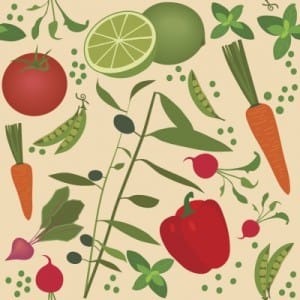The Atlantic
By Ari LeVaux
The real dispute is over valid but competing priorities.

On April 23, the science journal Nature published a paper titled “Comparing the yields of organic and conventional agriculture,” by Verena Seufert et al. The mainstream press waded into the paper’s implications but had a hard time packaging them in a headline. CNN announced “Organic yields 25% lower than conventional farming,” while the Los Angeles Times proclaimed “Organic Farming, carefully done, can be efficient.”
Pundits have used the paper to support contrary arguments in the ongoing debates about organic agriculture. Such cherry-picking isn’t a huge surprise, given the issue’s divisiveness, said co-author Dr. Navin Ramankutty of McGill University.
“We made everyone equally unhappy,” he told me by phone.
The paper is a meta-analysis of previous studies comparing organic and conventional agriculture, and purports to be the second of its kind. The first, by another team in 2007, concluded that organic agriculture could outperform conventional agriculture, but parts of that study’s methodology were criticized. Seufert et al. took those criticisms into account, hoping to avoid similar challenges, and considered 66 studies that compared the yields of 344 different crops. In this sample, conventional techniques outperformed organic methods in terms of overall yield. In some circumstances, and with some crops, the difference is statistically insignificant. There are counterexamples as well.
Yield alone, the team writes, is “…only part of a range of economic, social and environmental factors that should be considered when gauging the benefits of different farming systems.”
This point is often overlooked in discussions of how best to feed the world. Farming methods impact the lives of all who share the ecosystem. They can pollute the environment or make use of what would otherwise have become pollutants. They can affect the nutrient levels in food and the health of farm workers. To assume that the best farming practice is the one that produces the highest yield is like observing that a Lamborghini outraces a bicycle, and thus should be the world’s only vehicle.
The paper asserts that the efficacy of various farming systems is context-dependent, and proposes that the apparent dichotomy between organic and nonorganic is overly simplistic. Hybrid systems, the paper suggests, should be considered in some contexts. Ramankutty used his personal approach to food procurement as an example of how a hybrid system might work.
“I often buy organic food,” he told me. “Partly it’s because of some maybe nonscientific fear of pesticide residues in food — although it looks like scientific evidence for that is not hard to get.
“On the other hand, I wouldn’t mind if a farmer was applying a little bit of chemical fertilizer. I may not buy food if somebody was applying pesticides, but I would certainly not mind if my farmer applied a little bit of chemical fertilizer on his farm. It’s when we use 200 kilograms per hectare compared to maybe 40 or 50 kilograms that the problem arises.”
The paper notes that many organic agriculture systems are deficient in nitrogen, and that production on such farms would benefit from more of it. But most conventional systems have more than enough nitrogen, thanks to the ease and cost of applying chemical fertilizer.
“The problem we have with nitrogen is that we use too much of it, in some parts of the planet,” Ramankutty told me. “Then it gets left behind in the soil, it leaches out into groundwater, causing water quality problems. It runs down rivers and into lakes and causes algal blooms.
“There’s a diminishing return to nitrogen application. If you’re applying more and more fertilizer, plants take up less and less of it. If nitrogen is heavily subsidized, that is if there’s no cost to applying nitrogen, then farmers won’t have any incentive to reduce the amount of nitrogen.”
Organic sources of nitrogen include manure, cover crops, fish emulsion, compost, and other sources, many of them labor-intensive. These sources of nitrogen do more than simply add “N,” as it’s called in the paper. They also add organic matter to the soil, which is crucial for the soil’s microbial activity and helps retain moisture.
Shoveling manure is a lot more work than applying chemical nitrogen. But as long as natural gas (from which the fertilizer comes) is cheap, chemical nitrogen will be too.
In developing countries, the farms considered in the studies analyzed by Seufert et al are export-oriented operations, usually certified organic by international third-party organizations. Ramankutty makes a distinction between subsistence farming (which may be organic by default due to lack of resources, but not intentionally organic), and “intensive organic” methods, which involve active techniques like composting and mulching. Subsistence farmers might not need to become certified organic if they’re not catering to an organic market, but nonetheless the use of organic methods can build soil, conserve water, and grow better crops.
“There is a hypothesis,” Ramankutty said, “that in developing countries, switching from subsistence to intensive organic can be beneficial. We unfortunately couldn’t test that, so all we could say in the paper is that there’s no evidence right now that the hypothesis is true. But that does not mean it’s not true. Absence of evidence is not evidence of absence.”
Looking forward, Ramankutty said, the team’s next step is “to look at the other side of the equation, the environmental outcomes. What do the environmental outcomes of organic vs. conventional farming look like?”
Those results, when they come, will no doubt further stir the pot in the ever-spirited debate over the best way to produce food. Ramankutty expressed regret that their paper has probably breathed new life into a polarized debate that’s a lot more complicated than a simple dichotomy between organic and conventional.
That said, the data does provide clues as to which practices might help in certain contexts. Several of the studies they analyzed demonstrated that organic techniques offer clear yield advantages in drought conditions, he said.

